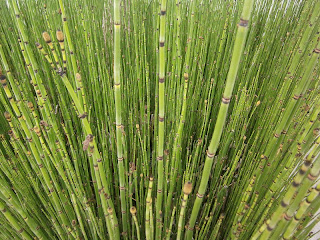A man strolls beside a water lily-covered pond during his lunchbreak. Several other employees have ventured outdoors among native ferns and wildflowers. Three wild turkeys meander along a nearby patch of grass. Native ferns, azalea, purple ironweed and other wildflowers paint different segments of the landscape.
 |
ORNL Natural Resources Manager Pat Parr
near Equisetum Beds and Blackgum Trees |
My host for this walk in the park is responsible for managing more than 33,000 acres in one of the world's most famous science centers. Although the area is not open to the general public, it serves as a model of reclaiming land for diverse, native wildlife, included in one of seven
National Environmental Research Parks around the country.
 |
| Oak Ridge National Laboratory |
 |
| Native Royal Fern |
Ecologist Pat Parr has been lending her expertise to this particular project at Oak Ridge National Laboratory for about five years now, while her distinguished career has included earlier accomplishments such as helping the larger park earn designation as a Biosphere Reserve. With research facilities nestled amid deciduous Appalachian forest land, Parr found natural inspiration for a comprehensive landscaping plan. When she needed to convert some conventionally landscaped areas into more sustainable green spaces, she brought the woods and water concept full circle.
 |
| Water Lilies Covering Pond at ORNL |
Parr has answered the challenge,
"How do you take an area that's fairly industrialized and make it more natural?" In one location, her team has constructed a rain garden to slow stormwater runoff, reduce erosion and improve water quality. Near another set of office buildings, they've improved the health of a former retention pond by propagating American lotus plants and encouraging a diverse wetland ecosystem. For every plant considered exotic or invasive by the Tennessee Exotic Pest Plant Council, of which Parr serves as a board member, there is a native plant alternative. The transformational project is making best use of natural resources while helping ORNL meet its sustainability mission. In the process, information is available to help government, businesses and individuals learn greener landscaping practices.
 |
| Equisetum Horsetails |
 |
ORNL Natural Resources Manager Pat Parr
Amid Mostly Native Landscaping Plants |
A large stretch of concrete broken up by square planting beds illustrates a unique connection between native plants and their particular setting. Under blackgum trees grow square patches of thin, jointed horsetails or Equisetum. Parr says these ancient plants descend from those that are now a source of fossil fuel. She calls it "an interesting landscape link between our federal energy mission and our energy heritage."
Tennessee businesses and individuals interested in sustainable landscaping with native plants can learn from Parr and other experts with the TNEPPC at an upcoming workshop September 21. Watch for more information about the workshop in downtown Oak Ridge at the
TNEPPC website.
 |
| Wild Turkeys on ORNL Campus |
THANKS FOR SHARING this post via the easy to use social media buttons below!








